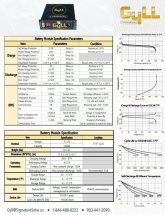Hello, I am about to buy an ALL -IN -ONE Inverter/Charger to complete my system and am looking for any advice or suggestions.
I already have the Panels (#36 ZNShine 390 Watt Bifacial panels) totalling just over 14kw; and
I already have the Batteries ( #5 GYLL Lifepower4 51.2V 100ah)
I have been leaning toward getting a Sol-Ark 12k, however I am not sure whether it is a good match for the above listed batteries. I HAVE read the other posts/threads about the Sol-Ark, including the potential issues of being able to communicate with the BMS in some battery set-ups/configurations.
The GYLL Batteries come with RS485 communication ports and cables.
Another concern I have is regarding the Charge and Discharge Voltage and Current specs of the Batteries vs those of the Inverter/Charger.
I am also considering an outback Sky Box set-up, but again I'm not sure if it would be a good match for these same GYLL Batteries and I'm open to any other suggestions.
Any input is greatly appreciated
Thanks
Max
I already have the Panels (#36 ZNShine 390 Watt Bifacial panels) totalling just over 14kw; and
I already have the Batteries ( #5 GYLL Lifepower4 51.2V 100ah)
I have been leaning toward getting a Sol-Ark 12k, however I am not sure whether it is a good match for the above listed batteries. I HAVE read the other posts/threads about the Sol-Ark, including the potential issues of being able to communicate with the BMS in some battery set-ups/configurations.
The GYLL Batteries come with RS485 communication ports and cables.
Another concern I have is regarding the Charge and Discharge Voltage and Current specs of the Batteries vs those of the Inverter/Charger.
I am also considering an outback Sky Box set-up, but again I'm not sure if it would be a good match for these same GYLL Batteries and I'm open to any other suggestions.
Any input is greatly appreciated
Thanks
Max



